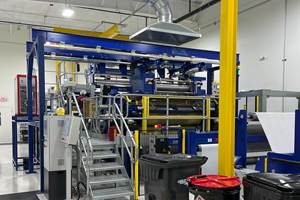Cytec gearing up for automotive expansion
With a new automotive-focused Application Centre set to open in December, Cytec Industrial Materials is emphasizing material and process flexibility to help OEMs integrate composites into forthcoming cars and trucks.

Cytec Industrial Materials (Heanor, Derbyshire, UK) is sending a strong signal to the automotive and composites industries on Dec. 3 with the opening of a new Application Centre in Heanor, designed to help the company develop material and process technologies for high-volume autocomposites fabrication.
Alex Aucken, global automotive director at Cytec Industrial Materials, says the company has “deliberately set out a strategy to address the needs that automotive industry has for high-volume production.” This requires, he says, developing a suite of capabilities that will allows Cytec to meet automakers on a variety of material and process levels, including fast-cure thermosets, thermoplastics, press-forming, high-pressure resin transfer molding (HP-RTM), automation and recycling.
Part of the challenge, says Aucken, and one of the reasons for the Application Centre, is determining where and how composites will eventually fit into the automotive supply chain. “One of our focuses is on the supply chain,” he says, “to make sure we have relationships with the Tier 1s, OEMs and suppliers.” Cytec, he adds, does not want to make automotive parts, but as it supports its customers, it needs to understand the process. “We want to help OEMs address their concerns about composites manufacturing and supply.”
One thing that is clear, says Aucken, is that automotive OEMs are not wedded to one material when it comes to addressing lightweighting and mechanical strength requirements. “The multi-material solution is best,” says Aucken. “No one material will be the ‘winner.’” Therefore, he adds, companies like Cytec must be willing to cooperate with aluminum and steel suppliers to develop joining and bonding systems that allow composites to be integrated with non-composites. So, add bonding and joining to the Application Centre’s to-do list.
Speaking more broadly, Aucken notes that Cytec is trying to position itself to take advantage of the automotive industry’s new cost paradigm, which represents a shift away from the age-old emphasis on unit cost. “There is a huge amount of focus by OEMs on the total cost of integrating composites, looking at CO2, tooling, weight savings,” he says. “This helps us make our case.”

Cytec’s capabilities, and what the Application Centre will develop, were on display in September at Composites Europe (Stuttgart, Germany), where the company featured, for automotive, filament winding, HP-RTM, preforming and compression molding:
- A carbon fiber-reinforced door inner structure manufactured from a filament wound flat blank using hot compression molding technology. The material offers high conformability required for complex shapes, combined with mechanical properties comparable to conventional prepregs.
- A carbon fiber-reinforced tailgate made from Cytec’s new rapid-cure epoxy prepreg MTM 710 and with sub-3-minute cure capability by hot compression molding.
- A complex part manufactured from UD carbon fiber using an automated preforming process that requires virtually no direct labor and is capable of producing parts such as structural automotive components for body-in-white structures with a sub-5-minute takt time.
- An HP-RTM demonstrator part made using Cytec’s XMTR750 two-component epoxy resin, with sub-3-minutes cure capability, a mold temperature of 130°C and with a resin injection time of less than 12 seconds.
Not at Composites Europe but also on Cytec’s radar, says Aucken, is overmolding, which combines composites with a well-known high-volume process and could be a valuable tool for automotive suppliers.
In any case, Aucken says the changes reshaping the automotive industry are creating unprecedented opportunity for the composites industry, and Cytec hopes to be among the first in line to take advantage. “The automotive industry is amazingly dynamic,” he notes. “The OEMs are constantly learning and adapting. It’s a very interesting time.”
Related Content
Materials & Processes: Tooling for composites
Composite parts are formed in molds, also known as tools. Tools can be made from virtually any material. The material type, shape and complexity depend upon the part and length of production run. Here's a short summary of the issues involved in electing and making tools.
Read MoreMaterials & Processes: Fabrication methods
There are numerous methods for fabricating composite components. Selection of a method for a particular part, therefore, will depend on the materials, the part design and end-use or application. Here's a guide to selection.
Read MoreMaterials & Processes: Resin matrices for composites
The matrix binds the fiber reinforcement, gives the composite component its shape and determines its surface quality. A composite matrix may be a polymer, ceramic, metal or carbon. Here’s a guide to selection.
Read MoreEpoxy-based structural film adhesive intended for aerospace, MRO
CAMX 2023: Park Aerospace is presenting its new aerospace-grade film adhesive material Aeroadhere FAE-350-1, in addition to other product offerings intended for aerospace, defense and spacecraft.
Read MoreRead Next
From the CW Archives: The tale of the thermoplastic cryotank
In 2006, guest columnist Bob Hartunian related the story of his efforts two decades prior, while at McDonnell Douglas, to develop a thermoplastic composite crytank for hydrogen storage. He learned a lot of lessons.
Read MoreComposites end markets: Energy (2024)
Composites are used widely in oil/gas, wind and other renewable energy applications. Despite market challenges, growth potential and innovation for composites continue.
Read MoreCW’s 2024 Top Shops survey offers new approach to benchmarking
Respondents that complete the survey by April 30, 2024, have the chance to be recognized as an honoree.
Read More


























